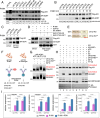Parp7 generates an ADP-ribosyl degron that controls negative feedback of androgen signaling
- PMID: 40681873
- PMCID: PMC12402299
- DOI: 10.1038/s44318-025-00510-4
Parp7 generates an ADP-ribosyl degron that controls negative feedback of androgen signaling
Abstract
The androgen receptor (AR) transduces the effects of circulating and tumor-derived androgens to the nucleus through ligand-induced changes in protein conformation, localization, and chromatin engagement. Defining how these events are integrated with signal transduction is critical to understand how AR drives prostate cancer and unveil pathway features that are potentially amenable to therapeutic intervention. We describe a novel post-transcriptional mechanism that controls AR levels on chromatin and gene output based on highly selective, inducible degradation. We find that the mono-ADP-ribosyltransferase PARP7 generates an ADP-ribosyl degron in the DNA-binding domain of AR, which is recognized by the ADP-ribose reader domain in the ubiquitin E3 ligase DTX2 and degraded by the proteasome. Mathematical modeling of the pathway suggested that PARP7 ADP-ribosylates chromatin-bound AR, a prediction that was validated in cells using an AR DNA-binding mutant. Non-conventional ubiquitin conjugation to ADP-ribosyl-cysteine and degradation by the proteasome forms the basis of a negative feedback loop that regulates modules of AR target genes. Our data expand the repertoire of mono-ADP-ribosyltransferases to include gene regulation via highly selective protein degradation.
Keywords: ADP-ribosylation; AR; DTX2; RBN2397; Ubiquitin.
© 2025. The Author(s).
Conflict of interest statement
Disclosure and competing interests statement. The authors declare no competing interests. BMP discloses that he is a co-founder of Define Therapeutics.
Figures








References
-
- Aravind L (2001) The WWE domain: a common interaction module in protein ubiquitination and ADP ribosylation. Trends Biochem Sci 26:273–275 - PubMed
-
- Bindesboll C, Tan S, Bott D, Cho T, Tamblyn L, MacPherson L, Gronning-Wang L, Nebb HI, Matthews J (2016) TCDD-inducible poly-ADP-ribose polymerase (TIPARP/PARP7) mono-ADP-ribosylates and co-activates liver X receptors. Biochem J 473:899–910 - PubMed
MeSH terms
Substances
Grants and funding
- R15 GM140409/GM/NIGMS NIH HHS/United States
- EP/W524633/1/Engineering and Physical Sciences Research Council (EPSRC) studentship through Doctoral Training Partnership
- R01CA214872/HHS | NIH | National Cancer Institute (NCI)
- R01 CA178393/CA/NCI NIH HHS/United States
- R01CA178393/HHS | NIH | National Cancer Institute (NCI)
LinkOut - more resources
Full Text Sources
Research Materials

